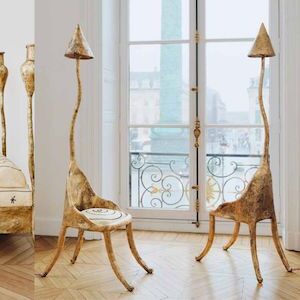Re-Emerging Craft
By Ariba Bashir
Craft is more than just a heritage that needs to be passed on to a new generation. It is about beautiful hand-made processes, the artistry of creation, the allure of uniqueness, so why did these ideas and this very notion become like a ‘dirty word’ this whole month on .Cent we are celebrating craft in its many forms, why not start here with our article Re-Emerging Craft
In the last few years, the idea of handcrafted one-off items went out of fashion potentially because of the ability to buy ready-made mass-produced goods cheaply and easily.
Interestingly in Britain, The Arts and Crafts movement was born from the ideal and as a reaction against a perceived decline in standards associated with machinery and factory production in the mid-19th century. Long since disregarded as we stomp to the ready appeal of mass-market.
The movement in its heyday highlighted an appreciation to nature, handcrafted artisan-made tiles, pottery, glass, furniture inspired from simple patterns and rectilinear and as a movement that aimed to preserve the integrity of nature. Bringing the limelight to finely crafted metal and wood, one of the primary artists associated with the movement was William Morris, a British textile designer, poet, artist, novelist, translator, and socialist activist.
During his lifetime, Morris produced items in a range of crafts, mainly those with the furnishing, including designs for wallpaper, textiles, embroideries, stained glass windows, three typefaces, and around 650 borders and ornamentations for the Kelmscott Press. He was best known in his lifetime as a poet, although he posthumously became better known for his designs. The exaggerated nature-inspired patterns became the identification of his work.
Many countries worldwide were looking to celebrate the natural world, and the movement that grew from Britain came later to be associated with Art Nouveau.
The aesthetics of each countries movement was rooted in the location. The purpose had always been to combine handcrafted art and design to fulfill each piece produced with the beauty and uniqueness of every area it was rooted in
Yet recently the essence of the quality of handmade products are re-emerging, especially because audiences are taking note of the sustainable aspect of mass-produced and wasteful productions.
Craftsmen making one-off items usually created from natural raw materials offer the consumer a much more individual offering and will usually be far greener than any factory produce item made of plastics. These artisans are focusing on new techniques combined with traditional methods to create things.
As our re-appreciation of craft returns, we see new glossy coffee table books arriving that explore the subject with rich images and informative text.
Artisan Design
Here in artisan design, some excellent examples can be explored, introducing 140 makers and 400 artisans using contemporary designs made from natural materials
The book also showcases the home interiors of the makers and those that collect pieces, in which crafted furniture is used to create highly unique environments

Art, Craft and community
Art, Craft, and community by Ludion, written by Antonia Williams, is another book that highlights statement-made handcrafted pieces. In this case, it is about hand-made books. Creativity, if you like, is a “book about books.”
The hint of personalization of these unique pieces can be seen in this book, the lost process of creating hand-made books can be found in this book.
The craftsmanship adds a connection between maker and buyer.
The process behind the final product and the history of craftsmanship seems to fade in technology over time. The realm of art and craft is making a comeback.
The art of craft is alive and well, so that new books celebrate the return to artisan movements.
If you enjoyed the reading re emerging craft, read the heart of craft here.
Find more about Artisan design here.
Find out more about Art, Craft and community here.






